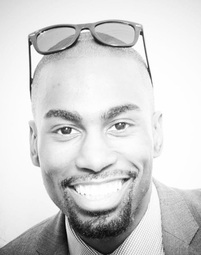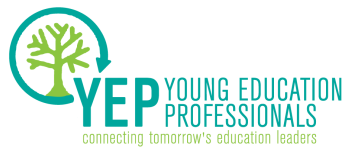 Courtesy of DeRay McKesson
Courtesy of DeRay McKesson As a Baltimorean, I know that this same spirit and commitment to education reform runs deep in Charm City. DeRay McKesson, who works for Baltimore City Public Schools, encompasses some of the best qualities of reformers in our area. He’s known for his intense work ethic and positive outlook, and he’s deliberately built a career that allows him to give back to his hometown in a big way.
After teaching sixth-grade math in New York City and working for the Harlem Children’s Zone, DeRay returned to his native Baltimore to found a new site for Higher Achievement and serve as a manager for the Baltimore City Teaching Residency (BCTR). From there, DeRay has moved up the district ladder to become the special assistant to the chief human capital officer, helping to oversee all personnel issues for the school system, from labor to licensure, placements to payroll. Here, DeRay shares his career evolution and how his work impacts students and staff districtwide.
Throughout my schooling, there were pivotal adults in my life who pushed me to be my best, who believed in me, and who expected more of me than I knew to expect of myself. I also worked at Baltimore’s Safe and Sound Campaign in high school, and my first manager, Robin, was the first adult to make me feel that my voice was legitimate and that my ideas were worthy.
I became a teacher because I wanted to be an adult that pushed and empowered kids too. I wanted to use content – in my case, middle school math – to equip my students with a set of foundational skills and a mindset that they’d have forever.
I’m no longer in the classroom and I miss it. There are few joys greater than seeing a child learn. In my roles after the classroom, I’ve focused on structural change at scale, with an attempt to work in positions that allow my actions to respond to the question, “How do we structurally (re)build, (re)organize, or enhance institutions (i.e. districts, agencies, elected offices) to become more effective at promoting student-centered decision-making?”
In just a few years, you've been able to move up quite a bit in the district. What has contributed to this success? Do you have any suggestions for YEP readers who may be looking to make similar moves in their career?
The classroom made me a patient person, and it was the first place that made me truly believe that gifts are everywhere. When I’m in a tough situation or not wholly invested in something or someone, I remind myself to “find the gift.” It sounds cliché, but it works and has changed everything.
If anything, my advice would be to: (1) find friends who respect your dreams – they will help sustain your quiet power; (2) work hard, harder than “normal” – your work is the outward manifestation of what you understand your time and energy to be worth; (3) don’t intentionally hurt people, and try to “find the gift” – it’s often not about being “nice” but more about being intentional about the energy you exude.
Coming from a career in direct service, what was the biggest adjustment to working at district headquarters? Is there anything you miss about working in the field/the non-profit sector? Anything you were happy to leave behind?
I will never not miss the classroom. I’ll never not miss seeing 11-year-olds effortlessly simplify quadratic expressions and own class discussions about process. There is a special magic and wonder in the classroom that does not exist anywhere else.
In district headquarters, there’s different energy. Each decision carries a weight that potentially impacts everything; each system and structure requires a deep dive that is more intense than you’d originally thought; and more people rightly need to be involved and consulted to get to the decision that is ultimately best for kids. In the classroom, teachers are responsible for individuals – for equipping, pushing, partnering with, and supporting individual students. At the district level, our lens is at scale. It is as if we are the general contractor and the owner of a house. Our first and basic role is to ensure that the house is stable, the bills are paid, and that nothing in the house will harm the inhabitants. And our second, and most important role, is to make sure that the people in the house thrive – that each inhabitant has what they need to grow, at all times. And that’s hard. It’s hard because we have a commitment to everyone, in every room, equally.
The district is an incredible way to be in the work of education. It is humbling to attempt to live up to the responsibility of supporting schools with such different needs. It is empowering to be able to help create structures, systems, and policies that allow classrooms to be stronger places of authentic learning.
The public tends to have strong opinions about large urban school districts, the initiatives they promote, and the priorities of senior leadership. What are some misconceptions that people have about working at district headquarters? How can the district and others in the education field help to improve school districts' public profiles?
The biggest misconception is that central office staff is disconnected from schools and thinks they are better than people working in schools. The reality is that central office staff have an incredible respect for school-based staff; it’s never lost on us that the work of the district happens in classrooms and that we – at best – are creating structures and supports that enhance what is happening in classrooms. And we understand that excellence manifests in many ways at the school-level, and we appreciate and want to strengthen the various forms this excellence can take.
The challenge is in how district-level decisions reach and impact schools. I think it’s a fair criticism that most large, urban school districts can do much, much better in roll-out and implementation of almost every initiative. But the implementation challenge is not because central office staff doesn’t value how schools will experience it.
Since you are the first Baltimorean featured on this blog, I have to ask: What are some things that Baltimore City Public Schools (BCPS) is doing that is worthy of DC's (and the nation's) attention? What are some things that BCPS could or should be doing to keep up with other districts?
I’ve always appreciated City Schools’ approach to reform across core bodies of work – this idea that it is less about one priority, but about a set of priorities across work streams that are in the best interests of kids. This means that at any given time, the district is managing large sets of high-impact, high-risk projects in the spirit of what’s right for kids. I appreciate the recognition that there isn’t one lever that will tip the achievement gap to close but that it’s the confluence of levers that will ultimately change the landscape for kids.
Specifically, our commitment to meet the demands of new ways of learning, our approach to test integrity, attendance, school climate, school leader pipeline – all of these are incredible. And, namely, our commitment to and implementation of fair student funding coupled with school-based budgeting and principal autonomy are unique in the urban school system landscape.
In the next phase of reform for City Schools, we can revisit how school autonomy manifests at the school level. There are districts that have developed interesting staffing models around school leadership – either by making an operational role within the school more explicit, providing more centralized support and oversight, or thinking more broadly about how to best support schools in a non-accountability way.
Amanda Klein is a community school coordinator in Baltimore, and her Q&As with local education leaders are a regular Recess feature. Send her your suggestions for future interviews via email.

 RSS Feed
RSS Feed